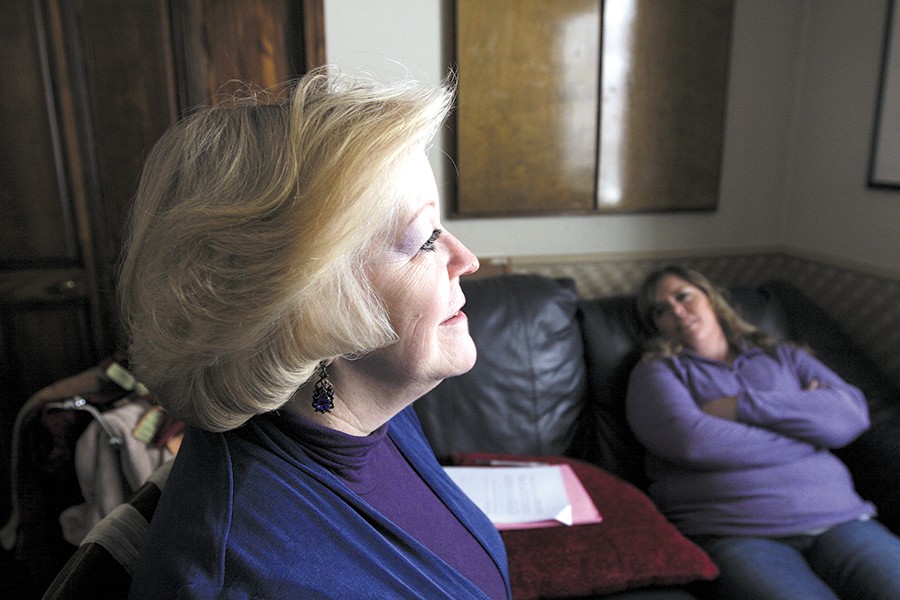When she describes giving birth to her son, Xylina Weaver uses a word you may not be used to hearing associated with childbirth: “easy.”
“I had maybe a total of five minutes of discomfort during the whole experience,” she says now.
In a photo from that day, she looks calm, submerged in a birth pool closing her eyes behind thin rectangular glasses, with her husband by her side. Weaver credits the stark contrast between that birth and the screaming and thrashing you see on TV to a cocktail of breathing techniques, visualization, affirmation and relaxation she learned from a curriculum called “HypnoBirthing.”
But for most, the idea of hypnosis almost immediately conjures images of carnivals or sideshows. Black-and-white spirals spin and spin, or a sharply dressed man sways a time piece, telling people they’re “getting very sleepy,” then convincing them to embarrass themselves in front of an enthralled crowd.
Hypnosis professionals have long contended there’s verifiable science behind the practice, which essentially involves inducing a state of relaxation that allows someone to access a deeper, subconscious part of the mind. The practice as we know it dates back to the mid 1800s, but some research suggests it harkens back to ancient religious techniques. Today, it’s accepted by the American Psychological Association.
“Although hypnosis has been controversial, most clinicians now agree it can be a powerful, effective therapeutic technique for a wide range of conditions, including pain, anxiety and mood disorders,” states the APA. “Hypnosis can also help people change habits, such as quitting smoking.”
Its history with the American Medical Association is shakier though. After being approved for medical purposes in the 1950s, the Association rescinded its support of hypnosis in the ’80s. Since then, clinical hypnosis groups have warned their members against falsely citing AMA support of hypnosis for any purpose.
Still, hypnosis is being used in various ways across the country and in our region, from childbirth to treatment of addiction and stress disorders.
Pioneered in the 1980s as a rebirth of ancient ideas about natural birth, HypnoBirthing teaches women techniques for reaching deep relaxation during labor. The philosophy centers on the idea that if a woman is anxious or tense during labor, stress hormones will flood her body and her energy will be used up in her extremities (like by clenching a bed rail). Techniques to stay calm can keep energy flowing to the uterus instead.
HypnoBirthing teaches women to conjure and repeat positive visions about birth, so that the goal to have an easy birth will sink deep into a woman’s mind and be with her when she’s actually in labor. Women listen to a relaxation CD repeatedly before the birth — when they’re relaxing around the house or falling asleep. They practice deep breathing and relaxation techniques, which are mostly ways to clear their minds of worry and distraction.
After having her second child with the help of HypnoBirthing, Weaver says she couldn’t help sharing the experience with other soon-to-be moms. She acknowledges she can’t promise every woman a painless birth, but she gives them “a series of tools and skills” to take with them when the time comes.
“We teach women in my classes to reduce stress by building confidence and decreasing fears,” she says. “We’re retraining the brain to believe in the body’s natural ability to give birth.”
“You’re going down a descending staircase,” Washington State University professor Arreed Barabasz tells his patient. There’s a stone structure, “like in a James Bond film,” he says. There are waterfalls and ferns, and there are three doors. The patient opens one door and makes her way down a hallway to a safe room. There, she’s 6 years old again and her brother’s in the room, the brother who abused her when she was that age.
The trauma has given the woman post-traumatic stress disorder and she’s with Barabasz to see if, through hypnosis, she can revisit the memory of the trauma and reframe the way she thinks about it. Barabasz wants to know too because he believes this is the future of treating PTSD for civilians and combat veterans alike. As the woman revisits the image of the perpetrator standing over her, Barabasz assumes the role of perpetrator and his female assistant becomes a supportive therapist. She tells the patient to “tell him off,” but the patient fears she’s too small and he’ll hurt her. The supporter promises she won’t let him and keeps up the encouragement. This is repeated over and over until the patient begins to shift her feelings. Soon, she’s empowered to tell the perpetrator he can’t hurt her, and to realize she’s not at fault for the trauma she’s endured. They repeat the process, again and again.
Scenarios like this are how Barabasz arrived at his most recent breakthrough in hypnosis research. A group of patients suffering from post-traumatic stress disorder was divided into two groups. Half of them received up to six-hour-long hypnosis sessions, while the other half did not receive the treatment. Barabasz found that while all the patients showed lessened symptoms of PTSD, the improvements only persisted for those who actually received the hypnosis. Today, a year after the experiment, 70 percent of those who were treated with hypnosis have maintained lessened PTSD symptoms.
“Anything above 50 percent is remarkable,” he says. “It’s pretty neat to be able to achieve this.”
Barabasz has spent more than 40 years studying hypnosis and is the editor-in-chief of the International Journal of Clinical and Experimental Hypnosis. He’s published books and manuals on hypnosis techniques, and today, along with his research, he teaches graduate courses at WSU in ethics, advanced psychotherapy and hypnosis.
With the latest findings, Barabasz hopes to train military psychologists to administer this type of therapy to combat veterans suffering PTSD, work that may eventually evolve into treating soldiers much sooner — on the battlefield.
A key cornerstone of hypnosis in therapy is identifying ego states, which are various parts of the human personality that don’t always act in concert. They’re not mappable parts of the brain, but metaphors for the way the mind works.
Ego states can be as simple as the differences between your personality at work and at a party, Barabasz explains. One may be more friendly or outgoing than the other, and they take turns dominating your personality, depending on your surroundings.
“Every normal person has ego states,” he says. “Normal people have different parts of themselves and they’re aware of those parts.”
When he hypnotizes PTSD patients in order to help manage the thoughts associated with their trauma, Barabasz is looking to access the ego state they were in when the trauma occurred (like the fearful, 6-year-old state of the woman who had been abused). Before beginning, patients map their ego states to give Barabasz a sense of which states they’re aware of, but, he says, during hypnosis they may access states they never knew existed.
“Communication among ego states helps to resolve the trauma through the collective interactions of all the states working toward mutually agreed-upon goals,” Barabasz writes in a paper on the recent PTSD research for publication in the International Journal of Clinical and Experimental Hypnosis. “For example, a fearful ego state learns it can depend on other ego states for courage and support.”
The breakthrough for PTSD patients undergoing hypnosis is called the “moment of abreaction” — the point when the ego state that is harboring the trauma realizes that it “no longer needs to be fearful, guilty or a victim,” Barabasz writes. “This is the basis for personality reconstruction.”
Barabasz argues this therapy is not only more effective for treating PTSD, but it makes more financial sense, too. For example, while the hypnosis treatment required just six hours, traditional PTSD counseling can often require months — or even years — of weekly meetings where patients talk about their trauma, but ultimately aren’t able to make any changes to how it lives in their mind.
Cost-savings were also demonstrated in a 2000 study by Harvard Medical School radiologists, who found that patients receiving hypnosis during surgery required less medication and had fewer complications. The researchers concluded that hypnosis could save $338 per patient.
And with the sustained, long-term results in the area of PTSD treatment, Barabasz thinks he and others can convince those in doubt of hypnosis’ effectiveness.
“Evidence-based [research] is what we need,” he says, “Evidence-based is what we have [in this study].”
Kathy Jo Avery spent 17 years as a nurse and still works the occasional shift in Sacred Heart’s emergency room, but today she practices therapy that she says some of her former co-workers view as less than mainstream. Avery owns Heartfelt Hypnosis, a local practice where she works with people struggling with ailments ranging from anxiety, depression and panic attacks to addiction or uncontrollable anger.
Avery began training to use hypnosis after she was in a late-night accident where a drunk driver slammed into her car. She had been enrolled in a master’s nursing program at Gonzaga University, but the injuries set her behind in her work. She went to counseling to work through the disappointment, and found that hypnosis was a more effective method for her than traditional therapy centered on talking. That, she believes, is because hypnosis accessed a deeper part of her mind that has more connection to her feelings and behaviors.
To help new patients understand this, Avery starts by telling them about their two minds — “the conscious and the unconscious.” The conscious, she says, is judgmental; it’s worried about black-and-white reasoning, about economics and to-do lists. The unconscious mind is emotional and holds memories. Through hypnosis, Avery says, she can get beyond the mind’s tendency toward judgment.
A negative behavior — like overeating — may be a result of a negative thought or feeling deeper within, something a person may not even be aware of — like loneliness or inadequacy — so the habit can’t truly be dealt with until its root is altered.
“It’s not as simple as hypnotizing someone and saying, ‘You don’t like potato chips,’” Avery says. “It’s more like helping them understand the meanings they’ve applied to things.”
While it may ultimately be important to find peace and meaning with what’s happened in your past, at Spokane’s Positive Changes, the concern is your future behavior.
“People who have PhDs and doctorates in counseling have learned to use hypnosis in their work as a therapist,”says Kevin Oliver, vice president of marketing for the Spokane location of the nationwide company. “That’s great. They want to get into the why. We are not counselors. We are not therapists. We do not do therapy. We do hypnosis that moves the client forward in a program.” The focus is on modifying your actions and habits because the organization contends that, “Almost all unwanted behavior is treatable,” says Oliver.
Specific programs have been developed for a number of issues including nail biting, anxiety, smoking cessation and pain relief. Programs for more esoteric things like sports performance, sales and “success motivation” are also available.
But losing weight is the focus of most of the company’s advertising. Oliver says the weight-loss approach at Positive Changes is based on helping clients “learn to eat like a naturally thin person.”
That means specific fat-inducing behaviors are identified — from drinking too much pop and not wanting to exercise, to never venturing into the produce section of a supermarket — and targeted for change through subconscious suggestions placed by the company’s hypnotists.
“What if you liked drinking water as your favorite drink? Would that be something you would be willing to work on?” says Oliver. “Maybe you think, ‘I hate to exercise.’ Hypnosis can give you the motivation to exercise. Can we make you go exercise? Absolutely not.”
That’s because hypnotic suggestion only allows you to do something you already desire to do. “It’s not brainwashing,” Oliver notes. “People have a fear that you’re going to get in my brain and make me do things I don’t want to do. Hypnosis can’t make you do things you don’t want to do.” In fact, he says, it usually won’t work for people who might be trying to lose weight to please a spouse, or quit smoking because a doctor told them to.
Oliver says the company is committed to helping people make healthy changes, including moderate weight loss that is sustainable. “If you need to lose 200 pounds, it is not healthy to do that in a year. We can give them the tools so that at some point, they will become the weight they want to be. Everything we do, especially with weight loss, is about doing it in a healthy fashion.”
On a recent snowy night, in an old yellow Victorian house on the lower South Hill, Weaver shows the five couples in her class a photo of a developed baby inside a womb, then of an opening blossom. She tells them to find the image that resonates best with them and hang it up where they’ll see it often. She dims the lights and plays a DVD on her laptop. The dated video — “videotaping isn’t allowed so much in hospitals anymore,” Weaver explains to the class — shows a woman with a large round belly smiling as she watches TV and eats Jell-O in a hospital bed. Soon she starts breathing more deeply, and within moments a rubber-gloved doctor is cleaning off her tiny, wiggling newborn.
“It’s like she’s sedated,” one of the soon-to-be moms whispers.
Weaver smiles and says, “Well, she kind of is because of all the endorphins.”
Soon, she shows the class how to relax into a deep state, clearing their minds of distractions. The five very pregnant women — and the men by their sides — will spend most of the weeks between now and labor reaffirming to themselves that their births will be positive, not negative experiences. Weaver is careful to remind them that it’s unlikely they’ll have totally painless births, but that their bodies are capable of giving birth.
“Just like any athlete who is successful visualizes having the perfect game, I encourage moms to envision what [they] want,” Weaver says. “Once your brain sees it over and over it’s much easier for that to happen.”


















